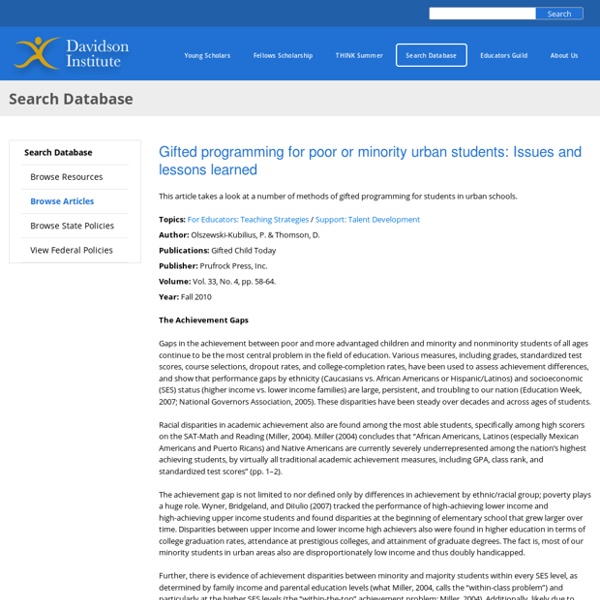



http://www.davidsongifted.org/Search-Database/entry/A10670
Related: Twice Exceptional and Gifted • Gifted Education History and Characteristics of Gifted LearnersNational Association for Gifted Children Separate studies conducted during the last few decades have demonstrated both the need for and the benefits of gifted education programs. Of special interest are the documented benefits that occur for all children when gifted education strategies and programs are extended to other students, as well. Simply stated . . . Why students in poverty are under-identified in gifted programs : aha! Process April 24, 2015 Published by Ruby Payne Conversations I have been a part of or overheard: “We would like to identify more minority and poor students, but they just don’t qualify. They do not meet our criteria.” “We did identify several minority and poor students, but they dropped out of the program within six weeks. We just cannot keep them in.”
Read About Best Practices in Supporting Gifted and Talented Students - Benchmark Education Storefront Characteristics of Gifted Learners Giftedness vs. High Achievement Schools are full of high achievers. These students typically have a positive attitude toward school and learning, pay attention in class, have the right answers when called upon, complete work quickly and neatly, and get along well with others. Many teachers misinterpret these behaviors for giftedness. Gifted Challenges: Who is the gifted underachiever? Four types of underachievement in gifted children There is a pervasive myth that all gifted people are high achievers.But many are not. Most young gifted children are a ball of energy, full of life, curious, intense, and driven. Then reality sets in. They confront the limitations of school, peer pressure, others' expectations and their own fears, and some scale back their drive. Their intrinsic love of learning seems to vanish overnight. Underachievement may develop gradually, with less effort expended on homework, tests or projects.
NSGT - Differentiating Learning for Gifted Students The Puzzle of Differentiating Learning for Gifted Students by Barbara Swicord, Ed.D. President, Summer Institute for the Gifted Differentiation is a term that is widely used in educational circles these days. There has been a noticeable increase in recent years in staff development offerings on differentiation strategies; schools’ goals and missions often use this concept in their statements; a great variety of educational literature addresses this topic.
Gifted Challenges: What causes gifted underachievement? Why does your gifted child struggle in school? Your child, once curious, energetic, overjoyed to learn, now has little interest in academics. As a parent, you stand by helplessly, saddened as you watch the spark disappear. Working with Gifted & Talented Students - TeachersFirst Working with a gifted student can be both a joy and a frustration. To understand why, we need to be clear about definitions. A gifted student is one whose intelligence - typically described as an IQ score resulting from one or more tests - is 130 or above. That is, giftedness is a measure of innate ability, not performance. Gifted Challenges: How to help your underachieving gifted child Any child who struggles in school is a challenge and a heartbreak for parents. But when gifted children veer off course, it can be especially troubling. We know what they are capable of, yet watch helplessly as they squander their talents and potential. Understand why your child is underachieving Underachievement springs from a variety of sources. You can't solve the problem without understanding its cause.
Free Gifted Resources and Curriculum The Best Gifted Resources and Curriculum We’ve Found: Mostly Free! Free Gifted Education Resources: Teaching Philosophy to Children: Lesson plans for all ages from the University of Washington Center for Philosophy for Children. The National Research Center on the Gifted and Talented (1990-2013) Click for an Introductory Video Clip (this clip requires about 60 seconds to load)..mpg This material was created for the Increasing Academic Achievement Study conducted by The National Research Center on the Gifted and Talented (NRC/GT) at the University of Connecticut. The NRC/GT developed five intervention strategies, and this intervention on Self-Efficacy was one of them. Throughout this website we will alternate between “he” and “she” when referring to a student to avoid gender inequity.
Twice Exceptional Children (2e) Federal Definition of "Giftedness" The US government defines "Gifted & Talented" students as those..."who give evidence of high achievement capability in areas such as intellectual, creative, artistic, or leadership capacity, or in specific academic fields, and who need services or activities not ordinarily provided by the school in order to fully develop those capabilities." 20 U.S.C. Section 7801(22). (Wrightslaw: No Child Left Behind, Title IX, Part A, (22). p. 526) Jacob Javits Gifted & Talented Students Education Act The Jacob Javits Gifted and Talented Students Education Act (Javits) was first passed by Congress in 1988 as part of the Elementary and Secondary Education Act and was most recently reauthorized through the Every Student Succeeds Act to support the development of talent in U.S. schools. The Javits Act, which is the only federal program dedicated specifically to gifted and talented students, does not fund local gifted education programs. Funding for Javits Program - Federal Fiscal Year 2019 (October 1, 2018–September 30, 2019) The Administration proposed cutting Javits for fiscal year 2019 (FY19). With the support of advocates, we were able to convince Congress to fund Javits.
Serving Gifted Students in General Ed Classrooms Gifted students who are served in general education classrooms frequently finish their work sooner than other students. This can happen in one subject area, such as mathematics, or in all subject areas. Due to their rapidity of thought (VanTassel-Baska & Brown, 2007), they typically finish assignments before other children. Then they may act out because they are bored. What is really going on is a mismatch between the academic needs of the student and the pace and depth of the curricula and instructional program. Following are suggestions for how to best serve these students -- and what not to do.